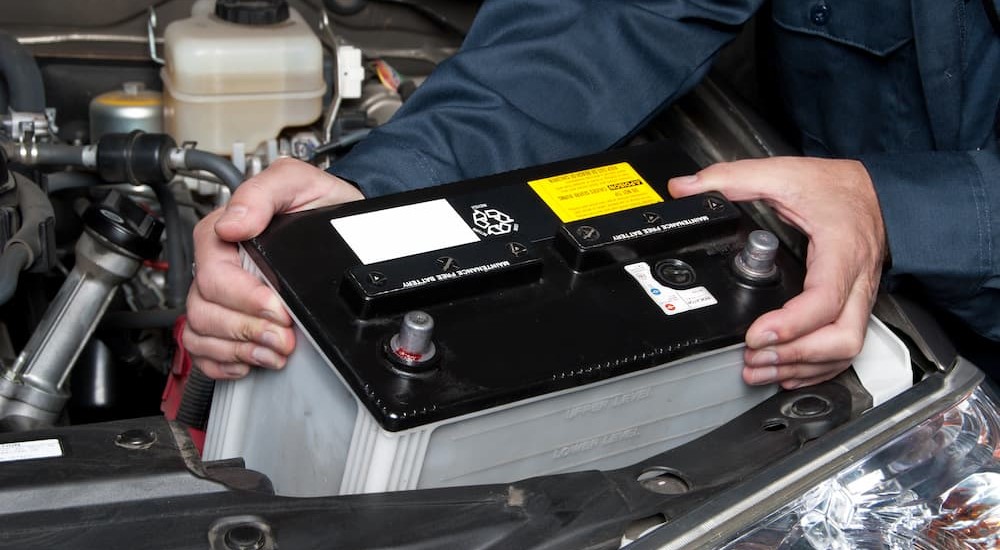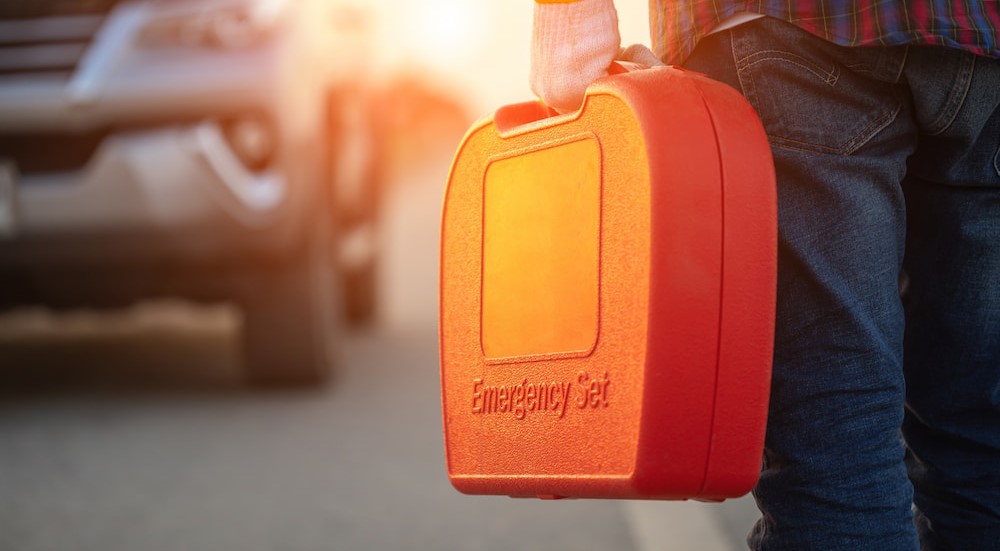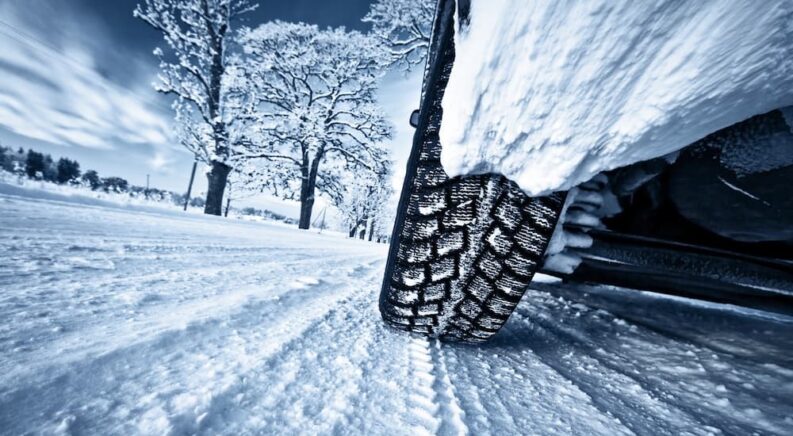Each season has its own unique demands, but winter is easily one of the more trying. From icy roads and frost heaves to low temperatures, shorter and darker days, and the visibility issues that can come with towering snowbanks, drivers can easily find themselves in hot water when it comes to navigating their vehicles through cold weather. If you live in a more temperate area of the country, you might be able to get away with a shorter list of preseason maintenance tasks. For those who know their way around a snowblower, a little pre-winter prep can make all the difference when Old Man Winter rears his ugly head.
To help you prepare for the colder months, we’ve compiled a brief list of five key maintenance tasks that should be part of your late fall routine. From checking your battery and tires to preparing a roadside emergency kit, swapping out some key fluids, and adopting good fueling habits, read on as we show you how your vehicle can not just survive but thrive throughout the winter season.
Replace Your Battery
A battery that’s already been giving you trouble during the warmer months is not going to get any better when the mercury starts to drop. Low temperatures can decimate a battery’s effectiveness, reducing available power by as much as 20 percent at 32°F. The chemical reactions inside the battery slow to a snail’s pace when freezing weather hits, but there are a few easy ways to address this issue. Replacing a battery that’s nearing the end of its service life is one obvious solution, but drivers should make sure to pay attention to one important number if they want to enjoy consistent starts throughout the colder months. Cold crank amps (CCA) are essentially a measure of how easily a car is going to start when exposed to low temperatures. Smaller vehicles, or those with four-cylinder engines, might be able to get away with a battery that has around 400 CCA, but those driving larger trucks and SUVs might want to opt for something closer to 600 CCA.
In addition to sourcing a stronger battery, drivers can also protect their vehicle from those long, frigid nights by keeping it parked inside their garage. If that’s not an option, or if your garage tends to be almost as chilly as the great outdoors, you can always invest in a battery warmer. Available for $50 to $100, these warmers are essentially an electric blanket for your battery. Simply plug them into the wall, wrap them around your battery, and you should be able to enjoy consistent starts all year round.

Check Your Tires
You would never venture into a winter storm in your sandals or slippers, but a surprising number of drivers don’t extend this same logic to their vehicle’s own footwear. Properly outfitting your vehicle with a set of snow tires, or simply measuring the depth and remaining tread life of your current set, can go a long way towards keeping you on the road when things start to freeze over. Even if you don’t think you need a dedicated set of snow tires, it’s always a good idea to give your current set a thorough once-over before the snow starts to fly. The classic penny test is a good way to gauge a tire’s tread depth, so find some loose change, insert a penny between the tire treads with Honest Abe’s head facing down, and if you can see the top of his head, make tracks for your nearest tire shop for a new set of rubber.
There’s just one caveat when selecting a new set of snow tires. There is technically no official standard for what is and is not a snow tire, which can confuse drivers when they’re in the market for a new set. Brands will advertise specific tires as being designed for winter use, but it’s ultimately up to drivers to do their research and use good judgment. Generally speaking, a good snow tire has a wide, deep tread with plenty of grooves, as well as a softer rubber compound that maintains its flexibility and grip in low temperatures. Studded tires offer an real advantage in terms of traction on ice, but they will also compromise a vehicle’s fuel economy, may not work as well in snowy rather than icy conditions, and create a steady drone that might start to get on your nerves. If you’re unsure of what tires to choose, you can always check in with your auto dealership or a trusted local mechanic. They’ll be familiar with the winter conditions in your area and can make a suggestion based on experience and the unique demands of your particular vehicle make and model.
You’ll also want to monitor your tire pressure as the winter months approach. Low temperatures can cause a tire to deflate by as much as one PSI for every 10 degrees, so monitor your PSI and top off the tires as needed.
Perform a Fluid Check
Engine oil, coolant, and windshield wiper fluid are all susceptible to freezing temperatures, which is why a thorough fluid check is an essential part of any pre-winter maintenance routine. We’ll start with motor oil. Despite what you might think, engine oil actually can freeze when exposed to extremely cold temperatures in the neighborhood of –20°F. While few drivers are likely to encounter that sort of chill, that doesn’t mean they’re out of the floods just yet. As it gets colder, motor oil becomes more viscous and starts to lose some of the properties that make it such an effective lubricant. This thicker oil can turn into a sort of sludge that will fail to penetrate the deeper reaches of your engine, forcing the vehicle to work harder and possibly leading to accelerated wear and tear. Switching to a less viscous motor oil designed for winter weather can help to stave off such performance issues.
Next, there’s coolant. While the idea of “cooling” anything might seem a little contradictory when discussing winter driving, remember that coolant is another word for antifreeze. This antifreeze effectively lowers the freezing point of the water in your cooling system, preventing the formation of ice and allowing the system to effectively manage the engine’s temperature. Without the proper coolant, drivers risk the sort of freezing and subsequent expansion that can damage sensitive engine parts. This coolant also helps to inhibit the formation of rust on gaskets found throughout the cooling system. Finally, coolant is part of your vehicle’s heating system. It transfers heat from the engine to the interior through the heater core, which is essentially a small radiator inside your climate control system to keep you warm when it’s cold outside. You don’t necessarily need to perform a full coolant flush and replacement before winter starts, but regularly checking up on the overflow reservoir and using the right formula for your specific vehicle should definitely be part of your routine.
Windshield wiper fluid might not play a critical role in the performance of your engine, but it certainly impacts safety. The ability to quickly and efficiently ocean off your windshield can’t be discounted, but wiper fluid can easily be compromised if it freezes into a blue slush. Spring for a bottle of winter formula wiper fluid, which has a lower freezing point than the regular variety used during the rest of the year. It’s also never a bad idea to replace your wiper blades going into the winter season, especially if you can find a set designed specifically for snow and ice.

Pack an Emergency Kit
In the words of Benjamin Franklin, “by failing to prepare you are preparing to fail”. While the Founding Father was born a little too early to experience the dreaded roadside winter breakdown, his words are still relevant in the era of internal combustion. Most drivers keep a basic roadside emergency kit in the trunk of their vehicle, or at the very least a set of jumper cables, but harsh winter weather demands its own unique arsenal of supplies. First, there are the accessories that’ll help get you back on the road, like the aforementioned jumper cables, as well as a shovel, ice scraper, and traction pads or recovery boards. A portable booster pack can not only help to get your engine started without the help of another vehicle, it can also be an essential lifeline when it comes to keeping your smartphone or other important electronics charged.
Next are those supplies that will come in handy if you end up spending a couple hours, or even a night, awaiting rescue. A spare set of winter clothes, including hats, gloves, and thick socks will keep you nice and cozy, as will a Mylar emergency blanket, disposable hand warmers, or an electric blanket that plugs into your vehicle’s 12-volt accessory outlet (or booster pack, if it has one). Non-perishable food and a couple bottles of water can help stave off hunger, while a first-aid kit will allow you to treat any minor scrapes or cuts you might have sustained when you went off the road. No driver expects an impromptu roadside campout, but if you do find yourself marooned by winter weather, you’ll be glad that you planned ahead.
Keep the Gas Tank Full
We all know, or have possibly even been, the type of driver that only adds a few gallons of gas to their tank at a time. In theory this practice might help you save a few dollars, especially in the summer when gas prices tend to hit a high point, but this penny-pinching approach could end up costing you when winter weather rolls in. Keeping your gas tank at least half full throughout the colder months offers two distinct benefits. The first comes down to condensation. The emptier your gas tank is, the more room there is for condensation to form. This condensation introduces water in your fuel supply, resulting in not only spotty performance and possible misfires, but also potentially causing the gas lines to freeze up as ice starts to form. Drivers should also consider the consequences of finding themselves stuck in an emergency situation with a near-empty tank of gas. Without enough fuel to keep the car running, temperatures can drop rapidly. The warm clothes and Mylar blanket from your roadside emergency kit might keep you from some of the worst outcomes, but a vehicle’s heating system is a whole lot more effective when you’re trying to stay warm. Being able to keep the vehicle running also means that you’ll be able to keep your smartphone charged, which is always important when you’re trying to contact a roadside emergency service or are awaiting updates from a tow truck.
Speaking of heat, make sure to replace your vehicle’s cabin air filter as you enter the cold season. This filter, typically located behind your vehicle’s glovebox, is responsible for scrubbing the air entering the cabin from the AC system and heater. When this filter becomes clogged, it can cause the heater’s blower motor to work overtime, stressing it out and possibly leading to total failure. This could lead to some chilly drives, so it’s best to not neglect this task as the days start to get shorter. Fixing a blower motor can be as expensive as $400, while a cabin air filter should only run you about $25 at your local auto parts store.
The winter months can be stressful for any driver, especially if you haven’t set yourself up for success with a little pre-winter vehicle prep. Snow and ice-covered roads, hulking plow trucks, and the accelerated corrosion associated with road salt are some of the more obvious dangers associated with winter driving, but they’re not the only risks to keep in mind. Swapping out your motor oil and wiper fluid for specialized winter blends, keeping an eye on your coolant levels, and maintaining a full tank of gas can all pay dividends when things get frosty. Investing in some good snow tires might not be cheap, but you should remember that they’ll allow you to squeeze a little more life out of your primary set. A portable jumper pack, new cabin air filter, or a new battery with plenty of CCA are all valuable additions to your holiday wishlist, and will allow you to brave the elements until spring rolls around.

